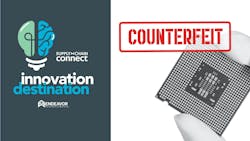Counterfeit Chronicles: Episode 5 – Critical Standards and Certifications for Combatting Counterfeits
In this episode of Innovation Destination Counterfeit Chronicles, we discuss the ins and outs of the most critical standards and certifications necessary to understand in order to safely and successfully navigate the electronic components industry.
This interview was edited and formatted for clarity.
Tyler Fussner, Managing Editor, Supply Chain Connect
Hello, and welcome back to Counterfeit Chronicles. As always, I’m your host, Tyler Fussner, Managing Editor at Supply Chain Connect, and joining me again today is Richard Smith, the Vice President of Business Development at ERAI.
Hey, Richard!
Richard Smith, Vice President of Business Development, ERAI
Hey, Tyler! How are you doing today?
Fussner
Doing well. How are you?
Smith
Great, thanks.
Fussner 0:34
Today I wanted to talk to you about the standards across the electronics industry that are critical to understand in order to safely and successfully navigate the landscape that is the electronic components industry. An important one that comes to mind to me is the SAE’s Counterfeit Electronic Parts; Avoidance, Detection, Mitigation, and Disposition Standard - AS5553.
Smith 0:57
Standards are very important. It's not really new to the industry. We're going to talk specifically about standards and how it relates to counterfeits, but most of these standards, the AS5553A and AS6081 and 6171, and we're going to talk about these, they all come from SAE.
SAE goes back to about 1905. SAE used to stand for the Society of Automotive Engineers. They were founded in 1905. They gave us all the threads and the bolt sizes and things like that, standardized all that to the automotive industry. And then in 2006, they changed their name to SAE International to reflect their 138,000-plus global members. And they're involved in so many other industries, in addition to automotive.
When I got in this business in the ’70s, there was a standard that had been around called JEDEC. JEDEC stood for the Joint Electronic Device Engineering Council. JEDEC’s roots go back to 1944, an organization called JETEC and that was the Joint Electron Tube Engineering Council. They set the standards for all the vacuum tubes that the world was using. And in 1958, (a very good year, by the way) JEDEC split off and formed a Joint Electron Device Council to deal with semiconductors and memory and chips. They gave us early standards for packaging sizes, pin outs, things like that. So, standards have always been around to give the industry an opportunity to share technology so that things can be used universally and across several formats.
ERAI got their first counterfeit part in 2001. We started collecting that data and our founder, Mark Snider, recognized this as a potential problem. He started talking us up with the defense contractors and the military and things like that. It wasn't until June of 2007 that the Navy asked the Bureau of Industry and Science to do a study. What they learned was that through the survey 35% of all the participants had dealt with some sort of counterfeit components in the years between 2004 and 2007 or 2008. This prompted the Department of Defense to come out with the DFARS (Defense Federal Acquisition Regulations Supplement), section 818-A, and that eventually gave us the AS5553A standard. It was put together by the industry; the G-19 Committee spent a long time putting together that standard. It came out in 2009. It has been revised several times, and they are currently at AS5553 Revision D, and that was published in 2022.
AS5553 is a standard for manufacturers, and it deals with things like best practices, how to vet your vendors, and then it will involve some inspection and testing techniques to help determine what a counterfeit device is and what you do with it, how you dispose of it, things like that. So, it covers manufacturers. The industry started to improve a great deal from there, but there are many, many segments of the industry and many, many standards to cover them.
Listen to the rest of the episode on the podcast player above or below, or wherever you listen to podcasts, picking up at the 4:56 mark!
About the Author
Tyler Fussner
Managing Editor - Community Manager | Supply Chain Connect
Tyler Fussner is Managing Editor - Community Manager at Supply Chain Connect, part of the Design & Engineering Group at Endeavor Business Media.
Previously, Fussner served as the Associate Editor for Fleet Maintenance magazine. As part of Endeavor's Commercial Vehicle Group, his work has been published in FleetOwner magazine, as well as Bulk Transporter, Refrigerated Transporter, and Trailer-Body Builders.
Fussner's May 2022 print feature 'The dawn of hydrogen trucks' was named the best single technology article in B2B by the judges of the 2022 Folio: Eddie and Ozzie Awards. Fussner was also awarded Silver in the Technical Article category for the Trade Association Business Publications International (TABPI) 2021 Tabbie Awards.
Fussner previously served as Assistant Editor for Endeavor's Transportation Group on the PTEN, Professional Distributor, and VehicleServicePros.com brands.
Fussner studied professional writing and publishing at the University of Wisconsin-Whitewater. He has experience in shop operations, is a Michelin Certified Tire Technician, and a Michelin Certified Tire Salesperson.







